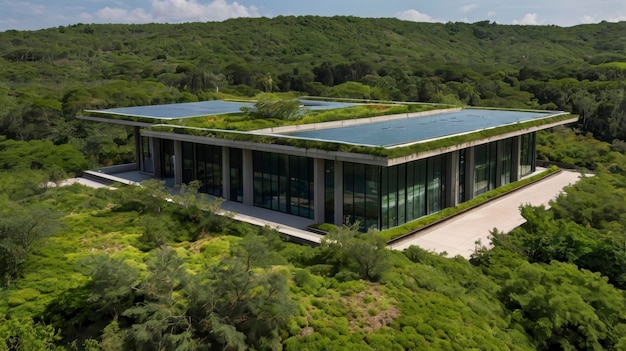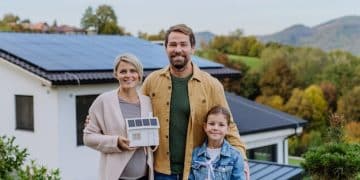Green Building Materials for Sustainable Homes: Build/Renovate Greener

Exploring green building materials: Build or Renovate Your Home with Sustainable Materials presents a vital pathway to eco-conscious living, offering tangible benefits for the environment, long-term cost savings, and healthier indoor environments.
In an era increasingly defined by climate consciousness, choosing to Green Building Materials: Build or Renovate Your Home with Sustainable Materials has transcended a mere trend to become a fundamental pillar of responsible living. This approach not only lessens your environmental footprint but also profoundly enhances your indoor living quality and yields significant financial gains over time.
The Foundation of Sustainable Living: What are Green Building Materials?
Green building materials are those products used in construction that are environmentally responsible and resource-efficient throughout a building’s life-cycle: from siting to design, construction, operation, maintenance, renovation, and demolition. Their selection can significantly impact resource consumption, energy efficiency, the global environment, and the health of building occupants.
The journey towards sustainable construction begins with understanding what makes a material “green.” It’s not simply about being natural; it’s about a comprehensive evaluation of a material’s impact. This includes considering its embodied energy—the total energy required to produce and transport a material—and its end-of-life possibilities, whether it can be recycled, reused, or composted without harm.
Key Characteristics of Green Building Materials
Materials earn their “green” designation by exhibiting several key characteristics. These traits collectively contribute to a healthier planet and more sustainable structures. Understanding these features helps in making informed choices for any building or renovation project.
- Low Embodied Energy: These materials require minimal energy for extraction, processing, manufacturing, and transport. This significantly reduces the carbon footprint associated with their production.
- Recycled Content: Use of materials made from recycled waste products, such as reclaimed wood, recycled steel, or glass, reduces the demand for virgin resources and minimizes landfill waste.
- Durability and Longevity: High-quality, long-lasting materials reduce the need for frequent replacement, conserving resources and minimizing waste over time.
- Renewable Resources: Materials sourced from rapidly renewable resources, like bamboo or cork, that can be replenished without long-term depletion of natural ecosystems.
- Locally Sourced: Prioritizing materials available within a close proximity to the construction site reduces transportation costs and associated carbon emissions.
Embracing green building materials means looking beyond the initial cost and instead focusing on the lifecycle impact and long-term benefits. This holistic view acknowledges the interconnectedness of our choices with environmental health and future sustainability, making every material selection a step towards a more resilient and responsible future.
Beyond the Balsa: Exploring Diverse Green Building Materials
Stepping into the world of sustainable construction reveals an exciting array of materials, each with unique properties and benefits. From ancient techniques re-imagined to cutting-edge innovations, these options offer builders and homeowners diverse ways to achieve their environmental goals while maintaining aesthetic appeal and structural integrity. The right choice depends on specific project needs, local availability, and desired performance characteristics.
Innovative Natural and Recycled Options
The innovation in green building materials is constantly evolving, bringing forth new possibilities. Many of these solutions focus on utilizing what’s already available or naturally abundant, thereby reducing waste and conserving virgin resources. This includes exploring industrial byproducts and rethinking conventional materials.
- Recycled Steel: One of the most recycled materials globally, recycled steel significantly reduces energy consumption and greenhouse gas emissions compared to new steel production. Its strength and versatility make it ideal for structural elements.
- Reclaimed Wood: Sourced from old barns, factories, or deconstructed buildings, reclaimed wood breathes new life into timber that might otherwise be discarded. It possesses unique character, is incredibly durable, and avoids the need for new tree felling.
- Bamboo: A rapidly renewable resource, bamboo grows incredibly fast and can be harvested without harming the root system. Its strength is comparable to some hardwoods, making it suitable for flooring, cabinetry, and even structural applications.
- Recycled Glass Countertops: These visually appealing surfaces are made from crushed recycled glass embedded in a binder. They offer a durable, non-porous option that adds a unique aesthetic to kitchens and bathrooms while reducing landfill waste.
- Insulated Concrete Forms (ICFs): While concrete has a high embodied energy, ICFs combat this by combining concrete with insulating foam panels. This creates highly insulated, energy-efficient walls that reduce long-term heating and cooling loads, offsetting initial carbon costs.
Each of these materials represents a stride towards more responsible construction practices. They challenge conventional methods by proving that environmental stewardship can go hand-in-hand with strength, beauty, and practicality. The adoption of these diverse materials contributes significantly to the overall sustainability of any building project.
The Eco-Economic Equation: Benefits of Building Green
Opting for green building materials: Build or Renovate Your Home with Sustainable Materials is not solely an environmental decision; it’s also a smart financial and health investment. The benefits extend far beyond individual choice, contributing to broader societal well-being and economic stability. Understanding this multi-faceted value proposition can help solidify the case for sustainable construction.

Long-Term Savings and Increased Home Value
The initial investment in green building materials and technologies can sometimes be higher than conventional approaches. However, the long-term economic advantages often far outweigh these upfront costs, making it a wise financial strategy for homeowners.
- Reduced Utility Bills: Superior insulation, energy-efficient windows, and high-performance HVAC systems inherent in green homes drastically cut down on heating and cooling needs. This translates directly into lower monthly energy bills.
- Lower Maintenance Costs: Many green materials, like durable recycled steel roofing or reclaimed wood, boast exceptional longevity and resistance to wear, requiring less frequent repair or replacement and saving money over the home’s lifespan.
- Increased Resale Value: Homes constructed with green materials and sustainable practices are increasingly sought after by buyers. Their lower operating costs, healthier indoor environments, and modern amenities make them more attractive, often commanding higher resale values.
- Tax Incentives and Rebates: Many governments and local utilities offer incentives, tax credits, and rebates for homeowners who incorporate energy-efficient and sustainable features into their homes, further offsetting initial costs and boosting savings.
These financial incentives and long-term savings transform green building from an environmental ideal into a tangible economic benefit. It positions sustainable homes as not just better for the planet, but better for the pocketbook, making them an increasingly attractive asset in the real estate market.
Healthier Homes, Healthier Lives: Enhancing Indoor Environmental Quality
One of the most profound, yet often underestimated, benefits of choosing green building materials: Build or Renovate Your Home with Sustainable Materials is their significant impact on indoor environmental quality (IEQ). Traditional building materials can off-gas harmful volatile organic compounds (VOCs) and contain irritants that degrade air quality and affect occupant health. Green materials prioritize a healthier living space, contributing to overall well-being.
Mitigating Health Risks Through Careful Material Selection
The air inside our homes can often be more polluted than outdoor air, largely due to emissions from building materials, furnishings, and cleaning products. Green building principles directly address this by promoting the use of materials that minimize these exposures.
- Reduced VOCs: Many green paints, adhesives, sealants, and flooring options are formulated to have low or zero VOCs. This significantly reduces the release of chemicals that can cause respiratory issues, headaches, and other health problems.
- Mold and Moisture Control: Green building designs often incorporate strategies for effective moisture management, using materials that resist mold growth and promote better ventilation. This is crucial for preventing respiratory illnesses and allergies.
- Improved Air Filtration: Green homes often integrate advanced air filtration systems that work more effectively at removing pollutants, allergens, and airborne particles, leading to cleaner, fresher indoor air.
- Natural Light and Ventilation: Sustainable design emphasizes maximizing natural light and ventilation. This reduces reliance on artificial lighting and air conditioning, while also improving mood, productivity, and thermal comfort for occupants.
By consciously selecting materials that enhance indoor air quality and promote a connection with the natural environment, green building creates living spaces that are not just environmentally sound but also inherently healthier for those who inhabit them. This focus on well-being makes sustainable homes deeply valuable investments in human health.
Building Green: Practical Steps for Your Renovation or New Build
Embarking on a green building or renovation project can seem daunting, but breaking it down into manageable steps makes the process accessible and rewarding. Whether you’re planning a full new build or a minor renovation, integrating sustainable practices is achievable with careful planning and informed choices. The key is to think holistically, considering every stage of the project.

Planning Your Sustainable Project
A successful green project starts with thorough planning. This initial phase sets the stage for efficiency, cost-effectiveness, and environmental integrity. It involves research, consultation, and setting clear objectives for sustainability.
- Define Your Goals: Clearly articulate what you want to achieve. Is it energy independence, reduced water usage, or a healthier indoor environment? Specific goals will guide your material and design decisions.
- Research Materials: Dedicate time to research various green materials, comparing their properties, environmental impact, cost, and availability in your region. Look for certifications and reputable suppliers.
- Consult Experts: Engage architects, builders, and contractors experienced in green building. Their expertise is invaluable for navigating sustainable design principles, material sourcing, and construction techniques.
- Consider Lifecycle Costs: Look beyond initial purchase prices. Factor in installation costs, maintenance, expected lifespan, and potential energy savings when evaluating materials to understand their true long-term value.
By meticulously planning your sustainable project, you lay a strong foundation for a home that is不仅环保, but also durable, efficient, and comfortable for years to come. This proactive approach ensures that every decision contributes to your overall green building objectives.
Navigating Certifications and Resources for Green Building
As the demand for sustainable construction grows, so does the array of certifications and resources designed to guide and validate green building efforts. These tools provide a framework for achieving environmental benchmarks, ensuring transparency, and helping consumers identify truly sustainable homes and products. Understanding them is crucial for anyone serious about building or renovating green.
Understanding Green Building Certifications
Certifications offer a clear, standardized way to measure and verify a building’s environmental performance. They provide assurance that a project meets specific sustainability criteria and can significantly enhance a property’s market value and credibility.
- LEED (Leadership in Energy and Environmental Design): One of the most widely recognized green building rating systems globally. LEED certifies buildings based on points earned across various categories, including sustainable sites, water efficiency, energy and atmosphere, materials and resources, and indoor environmental quality.
- Passive House: Focuses on extremely rigorous energy efficiency standards, leading to ultra-low energy consumption for heating and cooling. It emphasizes air tightness, high-performance insulation, and heat recovery ventilation.
- ENERGY STAR: While not a full building certification, ENERGY STAR certifies individual products (like appliances and windows) and homes that meet strict energy efficiency guidelines set by the U.S. Environmental Protection Agency and Department of Energy.
- Living Building Challenge: Considered one of the most stringent and holistic green building certifications, aiming for truly regenerative buildings that produce more energy than they consume, treat their own waste, and are net-zero water.
These certifications serve as invaluable guides for builders and homeowners, offering a roadmap to achieving verifiable sustainability. They also provide consumers with confidence that their green building choices are backed by credible, recognized standards, making the path towards a more sustainable home much clearer.
| Key Point | Brief Description |
|---|---|
| 🌱 Resource Efficiency | Utilizing materials with low embodied energy and high recycled content minimizes environmental impact. |
| 💰 Economic Benefits | Long-term savings through reduced utility bills, lower maintenance costs, and potential tax incentives. |
| 🏡 Healthier Interiors | Materials with low VOCs and improved moisture control lead to superior indoor air quality. |
| 🛠️ Practical Application | Careful planning, expert consultation, and understanding certifications are key for successful green projects. |
Frequently Asked Questions About Green Building Materials
▼
Embodied energy refers to the total energy consumed throughout a material’s life cycle. This includes extraction, processing, manufacturing, transportation, and construction. Choosing materials with lower embodied energy significantly reduces the carbon footprint of your home, aligning with sustainable building practices and minimizing environmental impact from the very first stages of your project.
▼
While some green building materials might have a higher upfront cost, this is often offset by long-term savings. These savings come from reduced utility bills due to better insulation and energy efficiency, lower maintenance, and potential tax incentives or rebates. Considering the full lifecycle cost typically reveals green materials to be a sound financial investment over the lifespan of the building.
▼
Green building materials are often designed to emit fewer volatile organic compounds (VOCs) and other harmful chemicals commonly found in traditional materials like certain paints, adhesives, and flooring. By reducing these emissions, they create a healthier indoor environment, decreasing the risk of respiratory issues, allergies, and other health concerns for occupants, leading to better overall well-being.
▼
Absolutely! Green building materials are suitable for both new construction and renovation projects of all sizes. Even small changes, like updating old windows with energy-efficient ones or repainting with low-VOC paints, can significantly improve a home’s sustainability and indoor air quality. Many green solutions are designed for easy integration into existing structures, offering flexibility for any project.
▼
Several green materials are accessible for DIY enthusiasts. Options include low or zero-VOC paints, recycled content flooring (like bamboo or cork), natural insulation materials (such as cotton or denim), and reclaimed wood for decorative accents or small projects. Local hardware stores and specialized eco-friendly suppliers are increasingly stocking these sustainable choices, making green renovations more achievable for everyone.
The Path to a Greener Future, One Home at a Time
The decision to embrace green building materials: Build or Renovate Your Home with Sustainable Materials represents more than just a construction choice; it is a commitment to a sustainable future. By carefully selecting materials that prioritize environmental responsibility, energy efficiency, and occupant health, homeowners and builders contribute to a healthier planet and create living spaces that offer lasting value, comfort, and well-being. This evolving field provides endless opportunities for innovation and impact, proving that homes can indeed be sanctuaries for both people and the planet.





